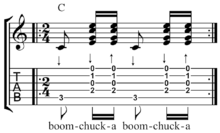Lick (music)
In popular music genres such as blues, jazz or rock music, a lick is "a stock pattern or phrase"[2] consisting of a short series of notes used in solos and melodic lines and accompaniment. Licks in rock and roll are often used through a formula, and variations technique in which variants of simple, stock ideas are blended and developed during the solo.
In a jazz band, a lick may be performed during an improvised solo, either during an accompanied solo chorus or during an unaccompanied solo break. Jazz licks are usually original short phrases which can be altered so they can be used over a song's changing harmonic progressions.
Similar concepts
A lick is different from the related concept of a riff, as riffs can include repeated chord progressions. Licks are more often associated with single-note melodic lines than with chord progressions. However, like riffs, licks can be the basis of an entire song. Single-line riffs or licks used as the basis of Western classical music pieces are called ostinatos. Contemporary jazz writers also use riff- or lick-like ostinatos in modal music and Latin jazz.
A lick can be a hook, if the lick meets the definition of a hook: "a musical idea, a passage or phrase, that is believed to be appealing and make the song stand out", and "catch the ear of the listener".[3] A lick may be incorporated into a fill, which is a short passage played in the pause between phrases of a melody.
For musicians, learning a lick is usually a form of imitation. Imitating style is as important as learning the appropriate scale over a given chord.[4] By imitating, musicians understand and analyze what others have done, allowing them to build a vocabulary of their own.
See also
- The Lick
- Vamp (music)
References
- Sokolow, Fred (1997). Complete Country Guitar Book, p.9. ISBN 978-0-7866-2841-4.
- Middleton, Richard (1990), Studying Popular Music, Philadelphia: Open University Press (published 2002), p. 137, ISBN 0-335-15275-9
- Covach, John. "Form in Rock Music: A Primer", in Stein, Deborah (2005). Engaging Music: Essays in Music Analysis, p.71. New York: Oxford University Press. ISBN 0-19-517010-5.
- Rengel, Matias (2015), 299 Insane Guitar Licks, Boston, p. 6, ISBN 978-1-5076-0464-9
